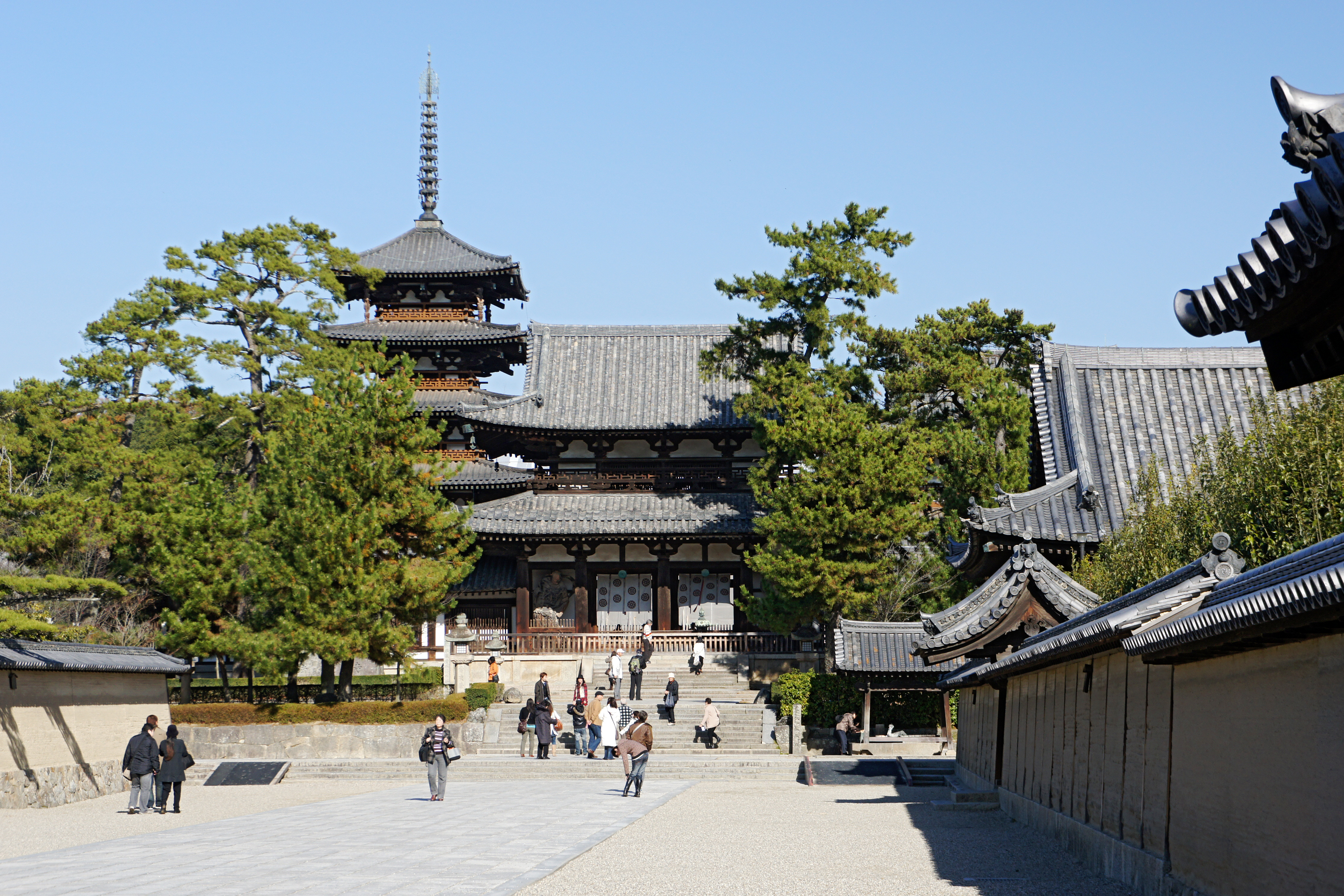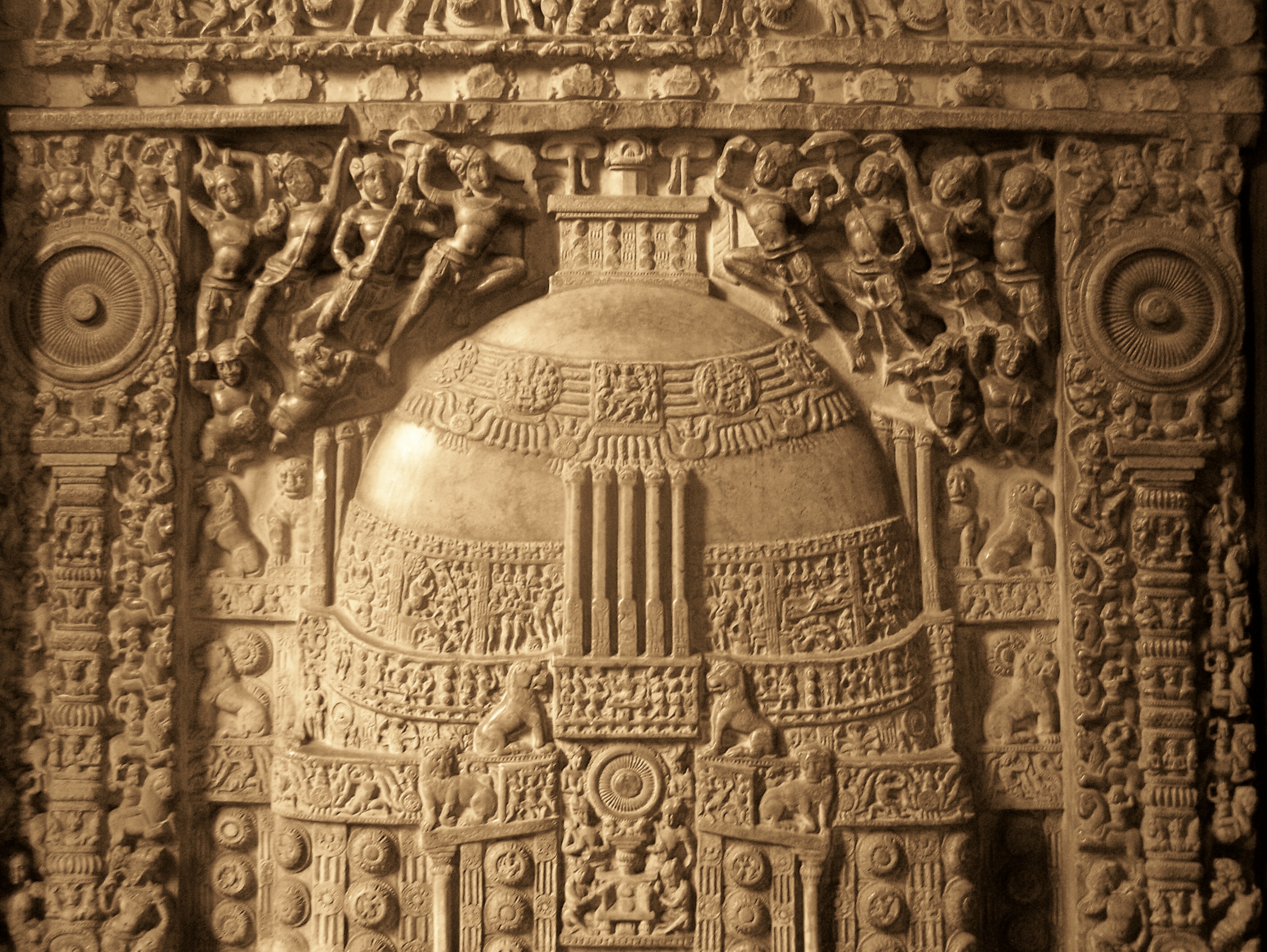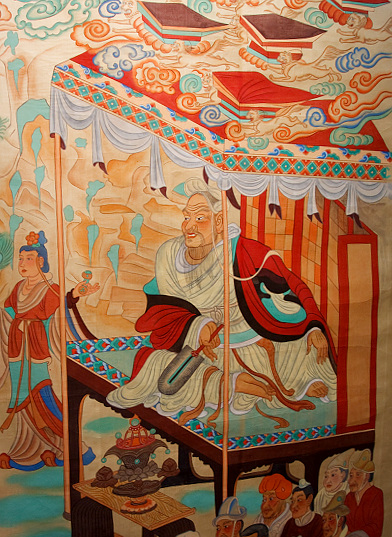|
Prince Shōtoku
, also known as or , was a semi-legendary regent and a politician of the Asuka period in Japan who served under Empress Suiko. He was the son of Emperor Yōmei and his consort, Princess Anahobe no Hashihito, who was also Yōmei's younger half-sister. But later, he was adopted by Prince Shōtoken. His parents were relatives of the ruling Soga clan and also he was involved in the defeat of the rival Mononobe clan. The primary source of the life and accomplishments of Prince Shōtoku comes from the '' Nihon Shoki''. The Prince is renowned for modernizing the government administration and for promoting Buddhism in Japan. Over successive generations, a devotional cult arose around the figure of Prince Shōtoku for the protection of Japan, the Imperial Family, and for Buddhism. Key religious figures such as Saichō, Shinran and others claimed inspiration or visions attributed to Prince Shōtoku. Genealogy Parents *Father: Emperor Yōmei (用明天皇, 517 – 21 May 587) *Mothe ... [...More Info...] [...Related Items...] OR: [Wikipedia] [Google] [Baidu] |
Kamakura Period
The is a period of Japanese history that marks the governance by the Kamakura shogunate, officially established in 1192 in Kamakura by the first ''shōgun'' Minamoto no Yoritomo after the conclusion of the Genpei War, which saw the struggle between the Taira and Minamoto clans. The period is known for the emergence of the samurai, the warrior caste, and for the establishment of feudalism in Japan. During the early Kamakura period, the shogunate continued warfare against the Northern Fujiwara which was only defeated in 1189. Then, the authority to the Kamakura rulers waned in the 1190s and power was transferred to the powerful Hōjō clan in the early 13th century with the head of the clan as regent (Shikken) under the shogun which became a powerless figurehead. The later Kamakura period saw the invasions of the Mongols in 1274 and again in 1281. To reduce the amount of chaos, the Hōjō rulers decided to decentralize power by allowing two imperial lines – Northern and S ... [...More Info...] [...Related Items...] OR: [Wikipedia] [Google] [Baidu] |
Twelve Level Cap And Rank System
, established in 603, was the first of what would be several similar cap and rank systems established during the Asuka period of Japanese history. It was adapted from similar systems that were already in place in Sui dynasty China, Paekche and Koguryŏ. The officials wore silk caps that were decorated with gold and silver, and a feather that indicated the official's rank. The ranks in the twelve level cap and rank system consisted of the greater and the lesser of each of the six Confucian virtues: , , , , and . The twelve cap system was replaced in 647. Innovations The primary distinction between this new system and the old '' kabane'' system by which a person's rank was determined based on heredity, was that the cap and rank system allowed for promotion based on merit and individual achievement. One of the more well known examples of promotion within the cap and rank system is that of Ono no Imoko was a Japanese politician and diplomat in the late 6th and early 7th centur ... [...More Info...] [...Related Items...] OR: [Wikipedia] [Google] [Baidu] |
Shōichi Watanabe
was an English scholar and one of Japan’s cultural critics. He is known for ultranationalist historical negationism. He was born in Tsuruoka, Yamagata Prefecture. A graduate of Sophia University, where he obtained his Master’s degree, he completed his doctorate at University of Münster in 1958. Two volumes of autobiography on his years in Germany narrate his varied experiences during this period. Returning to his alma mater, he became successively lecturer, assistant professor and full professor, until his retirement. He served as emeritus professor at the same university until his death. A passionate book-collector, he was chairman of the Japan Bibliophile Society. His personal collection of books on English philology (see Bibliography) was perhaps his most important contribution to the field of English philology in Japan, containing many rare items. History Shoichi Watanabe was born and raised in Tsuruoka, Yamagata. After receiving his Bachelor's degree and Master's ... [...More Info...] [...Related Items...] OR: [Wikipedia] [Google] [Baidu] |
Shinto
Shinto () is a religion from Japan. Classified as an East Asian religion by scholars of religion, its practitioners often regard it as Japan's indigenous religion and as a nature religion. Scholars sometimes call its practitioners ''Shintoists'', although adherents rarely use that term themselves. There is no central authority in control of Shinto, with much diversity of belief and practice evident among practitioners. A polytheistic and animistic religion, Shinto revolves around supernatural entities called the . The are believed to inhabit all things, including forces of nature and prominent landscape locations. The are worshiped at household shrines, family shrines, and ''jinja'' public shrines. The latter are staffed by priests, known as , who oversee offerings of food and drink to the specific enshrined at that location. This is done to cultivate harmony between humans and and to solicit the latter's blessing. Other common rituals include the dances, rites of ... [...More Info...] [...Related Items...] OR: [Wikipedia] [Google] [Baidu] |
Kansai Region
The or the , lies in the southern-central region of Japan's main island Honshū. The region includes the prefectures of Nara, Wakayama, Kyoto, Osaka, Hyōgo and Shiga, often also Mie, sometimes Fukui, Tokushima and Tottori. The metropolitan region of Osaka, Kobe and Kyoto (Keihanshin region) is the second-most populated in Japan after the Greater Tokyo Area. Name The terms , , and have their roots during the Asuka period. When the old provinces of Japan were established, several provinces in the area around the then-capital Kyoto were collectively named Kinai and Kinki, both roughly meaning "the neighbourhood of the capital". Kansai (literally ''west of the tollgate'') in its original usage refers to the land west of the Osaka Tollgate (), the border between Yamashiro Province and Ōmi Province (present-day Kyoto and Shiga prefectures).Entry for . Kōjien, fifth edition, 1998, During the Kamakura period, this border was redefined to include Ōmi and Iga Provinces. ... [...More Info...] [...Related Items...] OR: [Wikipedia] [Google] [Baidu] |
Yamato Province
was a province of Japan, located in Kinai, corresponding to present-day Nara Prefecture in Honshū. Nussbaum, Louis-Frédéric (2005). "Yamato" in . It was also called . Yamato consists of two characters, 大 "great", and 和 " Wa". At first, the name was written with one different character (), but due to its offensive connotation, for about ten years after 737, this was revised to use more desirable characters () (see Names of Japan). The final revision was made in the second year of the Tenpyō-hōji era (c. 758). It is classified as a great province in the '' Engishiki''. The Yamato Period in the history of Japan refers to the late Kofun Period (c. 250–538) and Asuka Period (538–710). Japanese archaeologists and historians emphasize the fact that during the early Kofun Period the Yamato Kingship was in close contention with other regional powers, such as Kibi Province near present-day Okayama Prefecture. Around the 6th century, the local chieftainship gained nation ... [...More Info...] [...Related Items...] OR: [Wikipedia] [Google] [Baidu] |
Hōryū-ji
is a Buddhist temple that was once one of the powerful Seven Great Temples, in Ikaruga, Nara Prefecture, Japan. Its full name is , or Learning Temple of the Flourishing Law, the complex serving as both a seminary and monastery. The temple was founded by Prince Shōtoku in 607, but according to the '' Nihon Shoki'', in 670 all buildings were burned down by lightning. However, reconstructed at least 1,300 years ago, the Kondō (main hall) is widely recognized as the world's oldest wooden building. A fire that broke out during the dismantling and repair of the Kondō on January 26, 1949 destroyed a mural of the Asuka period, a national treasure, and shocked the Japanese. Based on this accident, the day when the fire broke out is now fire prevention day for cultural properties. In 1993, Hōryū-ji Temple, along with Hokki-ji, was registered as Japan's first UNESCO World Heritage Site under the name of ''Buddhist Monuments in the Hōryū-ji Area''. A tree ring survey conducted in ... [...More Info...] [...Related Items...] OR: [Wikipedia] [Google] [Baidu] |
Osaka
is a designated city in the Kansai region of Honshu in Japan. It is the capital of and most populous city in Osaka Prefecture, and the third most populous city in Japan, following Special wards of Tokyo and Yokohama. With a population of 2.7 million in the 2020 census, it is also the largest component of the Keihanshin Metropolitan Area, which is the second-largest metropolitan area in Japan and the 10th largest urban area in the world with more than 19 million inhabitants. Osaka was traditionally considered Japan's economic hub. By the Kofun period (300–538) it had developed into an important regional port, and in the 7th and 8th centuries, it served briefly as the imperial capital. Osaka continued to flourish during the Edo period (1603–1867) and became known as a center of Japanese culture. Following the Meiji Restoration, Osaka greatly expanded in size and underwent rapid industrialization. In 1889, Osaka was officially established as a municipality. The cons ... [...More Info...] [...Related Items...] OR: [Wikipedia] [Google] [Baidu] |
Settsu Province
was a province of Japan, which today comprises the southeastern part of Hyōgo Prefecture and the northern part of Osaka Prefecture. It was also referred to as or . Osaka and Osaka Castle were the main center of the province. Most of Settsu's area comprises the modern day cities of Osaka and Kōbe. History During the Sengoku period, the Miyoshi clan ruled Settsu and its neighbors, Izumi and Kawachi, until they were conquered by Oda Nobunaga. The provinces were ruled subsequently by Toyotomi Hideyoshi. The regents of Hideyoshi's son soon quarreled, and when Ishida Mitsunari lost the Battle of Sekigahara, the area was given to relatives of Tokugawa Ieyasu. It was from then on divided into several domains, including the Asada Domain. Sumiyoshi taisha was designated as the chief Shinto shrine (''ichinomiya'') for the province. [...More Info...] [...Related Items...] OR: [Wikipedia] [Google] [Baidu] |
Shitennō-ji
Shitennō-ji ( ja, 四天王寺, ''Temple of the Four Heavenly Kings'') is a Buddhist temple in Ōsaka, Japan. It is also known as Arahaka-ji, Nanba-ji, or Mitsu-ji. The temple is sometimes regarded as the first Buddhist and oldest officially-administered temple in Japan, although the temple complex and buildings have been rebuilt over the centuries, with the last reconstruction taking place in 1963. It is the head temple of the Wa Sect of Buddhism. History Prince Shōtoku was known for his profound Buddhist faith when Buddhism was not widespread in Japan during the 6th century. In order to popularize Buddhism, Prince Shōtoku lead a massive national project to promote Buddhism and he commissioned the construction of Shitennō-ji. Prince Shōtoku invited three Korean carpenters from Baekje. They brought knowledge and led the construction of Shitennō-ji. The commission of Shitennō-ji was part of a massive national project led by Prince Shōtoku. The temple buildings themselv ... [...More Info...] [...Related Items...] OR: [Wikipedia] [Google] [Baidu] |
Śrīmālādevī Siṃhanāda Sūtra
The ''Śrīmālādevī Siṃhanāda Sūtra'' (, '' of Queen Śrīmālā'') is one of the main early Mahāyāna Buddhist texts belonging to the Tathāgatagarbha sūtras that teaches the doctrines of Buddha-nature and "One Vehicle" through the words of the Indian queen Śrīmālā. After its composition, this text became the primary scriptural advocate in India for the universal potentiality of Buddhahood. History Brian Edward Brown, a specialist in Buddha-nature doctrines, writes that the composition of the ''Śrīmālādevī Siṃhanāda Sūtra'' occurred during the Īkṣvāku Dynasty in the 3rd century CE as a product of the Caitika schools of the Mahāsāṃghikas. Alex Wayman has outlined eleven points of complete agreement between the Mahāsāṃghikas and the ''Śrīmālā'', along with four major arguments for this association. Anthony Barber also associates the earlier development of the '' Tathāgatagarbha Sūtra'' with the Mahāsāṃghikas, and concludes that the ... [...More Info...] [...Related Items...] OR: [Wikipedia] [Google] [Baidu] |
Vimalakirti Sutra
The ''Vimalakīrti Nirdeśa'' (Devanagari: विमलकीर्तिनिर्देश) (sometimes referred to as the ''Vimalakīrti Sūtra'' or ''Vimalakīrti Nirdeśa Sūtra'') is a Buddhist text which centers on a lay Buddhist meditator who attained a very high degree of enlightenment considered by some second only to the Buddha's. It was extremely influential in East Asia, but most likely of considerably less importance in the Indian and Tibetan sub-traditions of Mahāyāna Buddhism. The word ''nirdeśa'' in the title means "instruction, advice", and Vimalakīrti is the name of the main protagonist of the text, and means "Taintless Fame". The sutra teaches, among other subjects, the meaning of nondualism, the doctrine of the true body of the Buddha, the characteristically Mahāyāna claim that the appearances of the world are mere illusions, and the superiority of the Mahāyāna over other paths. It places in the mouth of the upāsaka (lay practitioner) Vimalakīrti ... [...More Info...] [...Related Items...] OR: [Wikipedia] [Google] [Baidu] |






